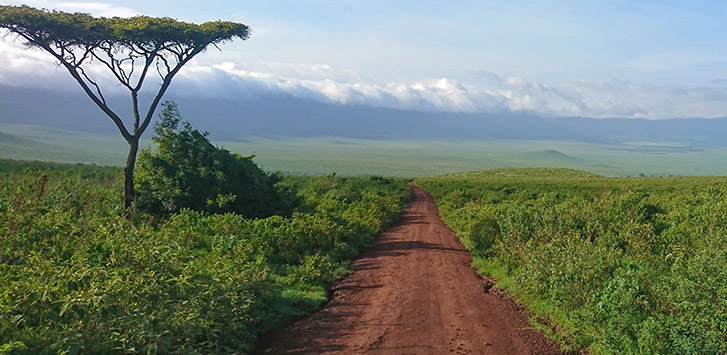Tanzanian coffee has a little something for everyone, whether you're a diehard fan of African coffees or not. Drawing from both Kenyan coffee and Arabian coffee, Tanzanian coffee easily makes a name for itself.
Africa is commonly acknowledged as the birthplace of coffee, causing many countries to quickly flourish. Compared to others, the Tanzanian coffee industry has developed slower. But that doesn't make it any less great.
The 3rd largest coffee producer in Africa, Tanzania has over 400,000 coffee farms. The coffee exports from these farms make up around 20% of the country’s revenue.
Borrowing strategies from neighboring coffee countries, Tanzania uses a similar coffee grading system as Kenya. The highest coffee bean is AA, followed by A, B, and so on.
One of the highest rated coffee beans, the Tanzania Peaberry is a rare African coffee varietal. Grown in the southwestern Mbeya region, the Tanzania Peaberry makes up 10% of the world's peaberry coffee. It's highly regarded for its unique flavor profile and well worth a try! If you're looking for a new coffee bean, check out our Tanzanian Peaberry today.

Growing Regions
Situated between Kenya, Rwanda, Malawi, and the Indian Ocean, Tanzania rests 1,400 to 1,800 meters above sea level. The rich, volcanic soil and high altitudes produce high quality, arabica coffee beans. Because of the high altitudes, the green coffee beans are often categorized as Strictly High Grown (SHG).
Tanzania has two harvesting seasons. Depending on the growing region, workers harvest the coffee cherries from April to May and July to August. After harvesting, the coffee beans undergo washed processing or natural processing.
Once the beans are processed and allowed to rest for a few weeks, they are quickly transported to the coast. The ease of transportation keeps the beans from spoiling, allowing Tanzania to export fresh, quality coffee beans.
Mount Kilimanjaro
The tallest peak in Africa, Mount Kilimanjaro is located near the Kenyan border. At just over 19,000 feet above sea level, this region is an oasis for coffee plants. Shaded by banana trees and fed by nutrient-dense volcanic soil, this coffee develops well. It is sweet and well-balanced with a pleasant acidity.
Southern Highlands
The Southern Highlands include multiple smaller growing regions, including Songwe, Mbeya, and Ruvuma. Protected by shade from numerous plants, these coffee beans are medium-bodied with bright fruity and floral notes.
Other Growing Regions
Mount Kilimanjaro and the Southern Highlands make up the majority of the Tanzanian coffee trade. But there are a couple, smaller growing regions that are worth mentioning. These include Arusha, Moshi, Pare, Songea, Mbinga, Iringa, Mara, to name a few.
The most distinctive coffees come from Moshi, Arusha, and Kilimanjaro.
.jpg)
Flavor Profile
If you've tried other African coffees, you'll find that Tanzanian coffee tastes familiar. It depends on where the coffee was grown, but these beans tend to be more fruity and bright.
Tanzanian coffee beans flavor notes range from blackberry to black tea to kiwi to cedar. Each cup has a light brown bread sweetness with a more muted acidity than other African coffees. Woven throughout are notes of unique spices, wine, and hints of chocolate. You’ll typically enjoy a medium body with creamy mouthfeel.
Tanzanian: Peaberry, Kilimanjaro
If you love notes of berries, dark chocolate, and spices, this coffee is for you. Enjoy fruity overtones balanced by raspberry, blueberry, orange, and dark chocolate. It’s a wild coffee, not held back by any rules or standards. Sourced from the Meru district, these Tanzanian peaberry coffee beans are washed processed, hand pulped, fermented, and sun-dried.
Brewing and Roasting Suggestions
Our Tanzanian peaberry coffee is best with a City Roast that accentuates the herbal and floral aromatics. But roasting is up to you and your preferences!
A lighter roast will bring out the fruity flavors and bright acidity. A medium and dark roast will emphasize the sweeter notes in the Tanzanian coffee. Once you’ve determined your favorite way to roast the coffee, you’ll need to brew your fresh roasted coffee!
If you’re not sure where to start, check out our Brewing Methods Guide. We discuss the best brewing methods based on roast levels.
Here’s a quick crash course. A light roast goes best with a pour over to truly emphasize the clean mouthfeel, subtle flavors, and light-body. A medium roast goes best with a cold brew to lessen the acidity and bitterness. You'll end up with a smooth mouthfeel and sweet flavors.
A dark roast goes best with a French Press, brewing a silky, smooth, yet full-bodied cup with dark, rich flavors. No matter the brewing method, you'll enjoy this cup of coffee!
Conclusion
Tanzania coffee beans brew an excellent cup of coffee. This coffee is great for people who like lower acidity coffees with wild, untamed, bright flavors. As some of the best African coffee, Tanzanian coffee is well worth a try.
Try it as a light roast or a dark roast. Brew it with a pour over or a French Press. Experiment with what you like and discover the best way to enjoy Tanzanian green coffee beans.